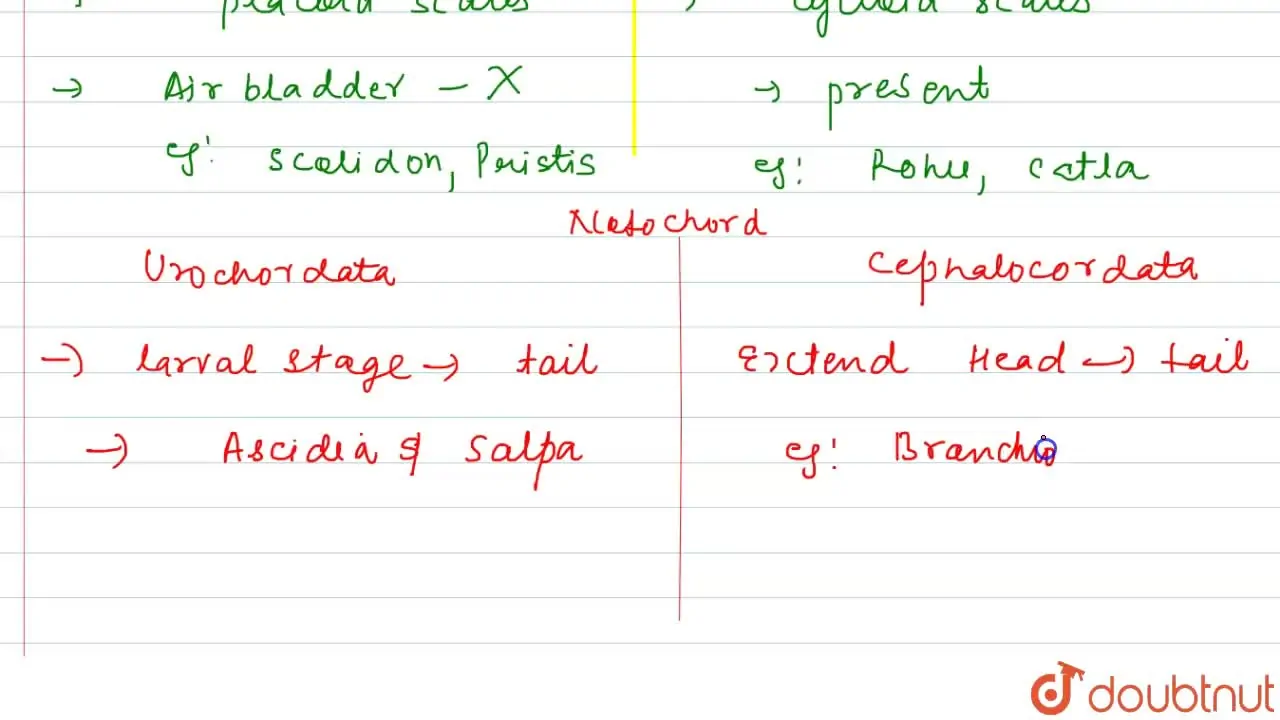Give the characteristics features of the following citing one example of each (a) Chondrichthyes and osteichthyes
(b) Urochordata and cephalochordata
Video Solution
Text Solution
Characteristic features of different classes mentioned are as follows
(a) Chondrichthyes
(i) These are marine animals with a stream lined body.
(ii) Body is has cartilaginous exoskeleton and the skin is tough due to the presence of minute placoid scales.
(iii) These animals are predaceous.
(iv) Due to the absence of air bladder they have to swim constantly to avoid sinking. (v) They are cold blooded animals e.g., Scoliodon (dog fish), Pristis (saw fish).
(vi) Some of them possess electric organs and poison sting (Torpedo and Trygon).
Osteichthyes
These animals are found in both habitats, i.e., marine and freshwater. They bear bony endoskeleton.
(ii) Bony is streamlined, posseses four pairs of gills covered by an operculum, on each side.
(iii) Skin is covered by cycloid or ctenoid scales.
(iv) Presence of air bladder is an additional feature providing buoyancy to animal.
(v) Heart is two chambered.
(iv) Sexes are seperate, fertilisation usually external, oviparous animal with direct development.
e.g., marine-Exocoetus (flying fish), Hippocampus (sea horse) , freshwater-Labeo (rohu).
(b) Urochordata
(i) In urochordates, notochord is only present in larval tail.
(ii) They contain a tough outer covering called tunic.
(iii) Persence of pharyngeal silts during some stage of the life cycle and a muscular, post anal tail is the characteristic features in urochordates. e.g., Salpa, Ascidia, Doliolum.
(i) Cephalochordates ate exclusively marine animals.
(ii) The notochord in cephalochordates extends. from the heart to tail region and is persistent throughout the life.
(iii) Body - wall shows one cell thick, non-ciliated epidermis, commective tissue, striated muscle and parietal peritonium.
(iv) Fertillisation is external
e.g., Branchiostoma (Amphioxus or Lancelet).
|
Updated on:21/07/2023
Related Playlists
- BOOK - NCERT EXEMPLAR ENGLISHCHAPTER - ANIMAL KINGDOMEXERCISE - LONG ANSWER TYPE QUESTIONS4videos
ANIMAL KINGDOM
- BOOK - NCERT EXEMPLAR ENGLISHCHAPTER - ANIMAL KINGDOMEXERCISE - VERY SHORT ANSWER TYPE QUESTIONS15videos
ANIMAL KINGDOM
- BOOK - NCERT EXEMPLAR ENGLISHCHAPTER - ANATOMY OF FLOWERING PLANTSEXERCISE - Long Answer6videos
ANATOMY OF FLOWERING PLANTS
- BOOK - NCERT EXEMPLAR ENGLISHCHAPTER - BIOLOGICAL CLASSIFICATIONEXERCISE - Long answer5videos
BIOLOGICAL CLASSIFICATION
Similar Questions
Give two characteristic features of Ramapithecus
View SolutionGive two characteristic features of Cro-Magnon man
View SolutionGive two characteristic features of each of the following:
RamapithecusView SolutionGive two characteristic features of each of the following:
Cro-Magnon manView SolutionGive one example of each domains.
View SolutionGive characteristic features that help a bird in flight.
View SolutionGive two characteristic features of parenchymatous cells.
View SolutionState one characteristic features of class Reptilia
View SolutionGive the characteristic features of Kingdom Plantae and Kingdom Animalia.
View SolutionGive a brief account of the following with one example of each: Sandmeyer reaction.
View Solution


